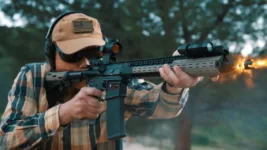The debate about whether law enforcement officers should use the conventional iron sights or the new-age optic sights on their patrol rifles has been ongoing for years. In fact, more and more law enforcement agencies around the country are now considering the obvious advantages of high-quality combat optics over iron sights, some even going to the extent of allowing officers to carry their own personal rifles fitted with optic sights while out on patrol duty.
The following information will help you understand the difference between the two and determine which one is a better choice for your patrol rifle.
Why Optic Sights
The most important factor that helps determine whether one should use an optic or iron sight on their rifle is the engagement distance; however, another important factor, the level of desired accuracy, also comes into play when making the decision.
Regardless of whether you use optic sights or iron ones, if you’re a police officer, you would have received training to use your patrol weapon for a range of nearly 100 yards, most likely with an iron sight. Aside from that, your training would also have taught you the art and science of precision shooting even with the good old iron sights.
However, the police force is increasingly encountering situations that require highly precise shooting at long distances. In such instances, optic sights are known to deliver better results—perhaps which is why law enforcement forces across the country are gradually shifting to optic sights.
Why iron sights seem to be losing favor
To use a rifle fitted with iron sights, the shooter needs to precisely and quickly line up the back and the front of the iron sights on their target. While this takes seconds, those few seconds or nanoseconds can make a world of difference in a real-life high-risk situation.
The precision required of a patrol rifle is hard to achieve with an iron sight, when compared to the ease with which an optic sight allows the shooter to achieve greater accuracy by simply pointing the reticle red light on the target and employing trigger control.
A good combat optic is great for shooting in low light and in the dark—one of its biggest advantages that possibly has the police wondering if they should completely stop using iron sights in their rifles.
In addition, an officer well trained to use a rifle with a high-quality combat optic can deliver follow-up shots at a greater speed and accuracy.
Lastly, an illuminated reticle optic sight makes it easier for law enforcement officers to spot and engage targets. A big plus point with red-light reticles is that you can adjust the level of light according to a situation and also your own comfort. This is not at all possible when using iron sights.
Some issues with optic sights
While optic sights have a number of advantages, one issue with combat optics used on long guns is that they are heavy and it may be difficult to balance the weapon for someone who’s new to using optics.
This remains a key concern; however, experts say that one should follow a simple ground rule when accessorizing a gun: keep the accessories to a minimum to prevent your rifle from becoming too heavy. Choose the accessories with care, paying due attention to the size and quality of the product as well its weight.
Just remember to ensure that the base of your gun is light, so that when you add a combat optic sight, a sling, a light and a loaded magazine, you would still be able to use it with ease.
To make an informed decision and buy trusted, high-quality accessories for your rifle, click here.
Which sight should you choose?
Your best bet is to train with both sights. However, when installing a sight on your patrol rifle, you need to consider the following factors.
Unlike an iron sight, an optic sight is prone to breakage, so it needs to be handled with greater care. You should ideally have iron sights as backup in such cases. Another important thing to consider is that every officer will need a different optic to look at targets, based on their personal comfort level. Train with optic sights that provide several different fields of view so that you know what you prefer most.
To sum up, if your agency does not yet allow using optics, use iron sights on your patrol weapon the best way you can.








